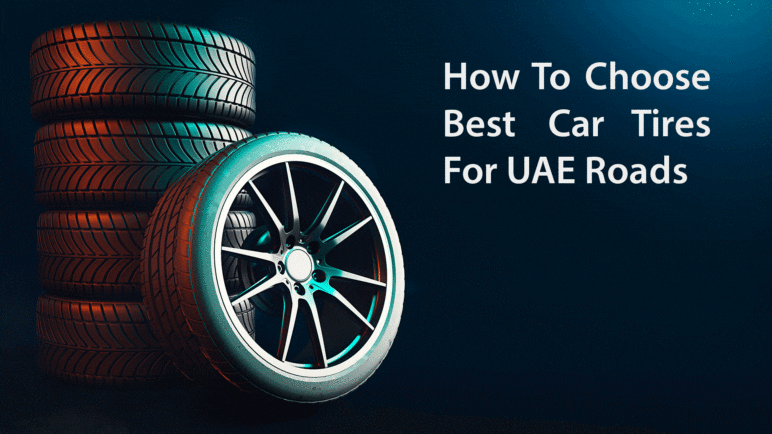You are driving down the Sheikh Zayed road on a hot summer day and all of a sudden your tire goes pop. Flat tires can be a nuisance. What’s even more cumbersome is scouring dealerships for quality tyres that are a good fit for UAE roads. Online customer reviews and rating websites are not sufficient when it comes to selecting new tyres, there is just too much to factor in. Here are some tips and pointers for making your next tyre hunt less painful and more informed.
People Always Talk About the Weather
When choosing the best car tyres for UAE roads, pay close attention to UAEs meteorological state — that is, its weather. The UAE remains hot for most of the year and it’s roads are dry. That is a recipe for significantly lower tyre life spans. So how do you extend that lifespan, you ask? By choosing the right tyres ofcourse!
The Best Tyre Type for UAE Roads
Seasonally, tyres are divided into three main classifications: summer, winter, all seasons, and off-road.
- Summer tyres: These are the most commonly fitted types in the UAE given the heat and dryness of the country. They are operational in mild weather conditions of 7 degrees Celsius and above. They are designed to have increased braking performance and cornering.
- Winter tyres: Winter tyres are softer and more elastic due to the higher proportion of rubber present in them. Thanks to their tread pattern, winter tyres offer better traction in wet and snow conditions.
- All season tyres: These multi-purpose tyres combine the features of both summer and winter tyres. They are ideal for drivers opting for superior treadwear, all the while not suffering the heat drawbacks experienced with winter tyres. All season tyres’ performance is a variant of all season tyres with high speed ratings and responsive braking.
- Off-road tyres: These are special tyres for driving on sandy, muddy, or grassy surfaces. Off-road tyres have wider grooves that boost a vehicles grip on loose surfaces. However, using them on roads adversely affects fuel efficiency due to increased rolling resistance and traction, thus they should only be used for off-road purposes.
Side Wall Code
All tyres have a series of numbers and letters imprinted on their side. They encode much of the details and specifics about the tyre. For a safe driving experience it is very critical to know about them.
Tyre Size
Information about the tyre size is encoded in the set of characters displayed using the largest font size on the tyres side. They looks something like this “P225/ 70 R 16 91S“. The first letter indicates the tyre type: P. The next set of numbers represent the width of the tyre from sidewall to sidewall measured in mm: 225. The following two numbers refer to the tyre’s aspect ratio, i.e, the ratio of the height of the tyre to its width: 70. The next letter indicates the construction of the tyre: R. Most modern tyres have the letter R for their construction, this means Radial. The subsequent two digits indicate the rim diameter in inches 16.
The following two numbers represent the load capacity (in weight) that the tyre can bear: 91. Load indices can be readily read off of tyre index tables readily available here.
The final letter is the speed rating: S. This indicates the speed limit that a tyre can endure before losing control. Similarly, speed ratings can be read off dedicated tables.
Other Letters and Symbols
In a usually smaller font than that used for tyre size readings, tyre sides also contain information on a cars treadwear, traction, and temperature. Each reading is displayed in a code, preceded by the title of its reading, for example “Treadware T60“. Here’s what each title means: a)treadwear: how fast a tyre wears out, b) traction grade; how well a tyre grips to the ground when its wet, and c) temperature grade: the tyres ability to withstand heat. The Emirates Standardization and Metrology Authority (ESMA) mandates that tyres in UAE must be able to withstand temperatures of 50 degrees Celsius.
Other Things to Consider When Choosing Tyres for UAE Roads
When purchasing a tyre or a set of tyres always try to strike a balance between these four major factors: durability, performance, quality, and pricing.
If you are buying used tyres, always check their date of manufacture on the sidewall and never buy tyres older than 5 years, it’s against the law. Also ensure that wheel tread depths are high enough. A low tread depth is a sure sign that a tyre is reaching the end of its lifespan. If the tyres tread depth is below 1.6mm, then it is actually illegal to drive on the roads of the UAE.
And if you are buying a set of four, try your best to ensure that they are all of the same brand, or at least the same size, speed rating, and load index.
Lastly, get in touch with a trusted tyre dealer and don’t rely on just any vendor without doing your due diligence.
Speaking of trusted dealers, we at Sell Your Motors offer the most trusted car buying services in UAE. We buy any car at fair market price in a hassle-free process that lasts less than 30 minutes. Try our free online car valuation here. Alternatively, you can get in touch with us on 04 330 103, and we will walk you through the selling process step by step.







